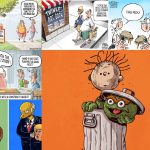Educational Value of Animated Cartoons: Animated cartoons, often dismissed as mere entertainment for children, have proven to be powerful educational tools. Beyond their colorful characters and catchy tunes, cartoons have the unique ability to engage, captivate, and educate young minds in ways that traditional methods may struggle to achieve. This article delves into the educational value of animated cartoons, exploring how they combine the elements of entertainment and learning to create a practical and enjoyable educational experience for children.

The Power of Visual Learning:
1. Visual Stimulation:
Humans are inherently visual learners, and animated cartoons tap into this preference by providing a visually stimulating learning environment. The vibrant colors, dynamic movement, and engaging characters capture children’s attention, making educational content more appealing and memorable.
2. Complex Concepts Simplified:
Animated cartoons excel in simplifying complex concepts through visual representation. Cartoons use visual metaphors, illustrations, and animations to break down information into digestible segments, whether explaining scientific principles, historical events, or mathematical equations. This approach helps children grasp abstract concepts more quickly.
3. Visualization of Abstract Ideas:
Many educational concepts are abstract and challenging for children to visualize. Animated cartoons bridge this gap by bringing abstract ideas to life. Cartoons provide visual representations that make these concepts more tangible and understandable, whether it’s the water cycle, the solar system, or the human body’s inner workings.

Engaging Storytelling and Narrative Structure:
1. Storytelling as a Learning Tool:
Animated cartoons often follow a narrative structure, weaving educational content into engaging stories. The power of storytelling lies in its ability to create context, making information more relatable and memorable. Educational cartoons use storytelling to present facts, historical events, and scientific principles in a way that captivates young audiences.
2. Character Development:
Characters in animated cartoons serve as relatable guides through the learning process. Whether it’s a talking animal, a historical figure, or a friendly robot, characters become companions for children on their educational journey. The development of characters helps build emotional connections, fostering a positive and enjoyable learning experience.
3. Educational Adventures:
Many educational cartoons take children on exciting adventures, combining entertainment with learning. These adventures provide a context for exploring new concepts, solving problems, and overcoming challenges. The narrative structure of cartoons turns learning into an immersive experience, encouraging children to participate actively in the educational journey.
Multisensory Learning Experience:
1. Incorporating Music and Songs:
Music and songs are crucial in educational cartoons, enhancing the learning experience. Catchy tunes and rhymes make information more memorable, aiding in retention. Whether it’s learning the alphabet, multiplication tables, or historical dates, incorporating music turns educational content into a multisensory experience.
2. Repetition for Reinforcement:
Animated cartoons often use repetition as a reinforcement tool. Repetitive patterns, songs, and visual cues help solidify information in children’s minds. The combination of repetition and visual elements creates a multisensory learning experience that caters to different learning styles.
3. Interactive Elements:
Some educational cartoons incorporate interactive elements that encourage children to participate actively. Whether answering questions, solving puzzles, or completing challenges, these interactive components turn passive viewers into engaged learners. The hands-on approach promotes a deeper understanding of the content.

Cultural and Social Learning:
1. Cultural Exposure:
Animated cartoons often feature diverse characters and settings, exposing children to different cultures, traditions, and perspectives. This cultural diversity fosters an understanding and appreciation for the world’s richness, promoting tolerance and empathy.
2. Social Skills Development:
Cartoons frequently depict social interactions, friendships, and problem-solving scenarios. These portrayals contribute to the development of social skills in children. Characters navigating conflicts, expressing emotions, and working together are valuable examples for young viewers, fostering social and emotional intelligence.
3. Moral and Ethical Lessons:
Many educational cartoons incorporate moral and ethical lessons within their narratives. Through character dilemmas, ethical choices, and consequences of actions, cartoons help instill values and principles in children. These lessons contribute to developing a moral compass and guide children in responsible decisions.

Technology Literacy and Digital Skills:
1. Early Exposure to Technology:
Early exposure to technology is essential for children’s development in the digital age. Educational cartoons often leverage animation, interactive elements, and digital platforms, providing a foundation for technology literacy. Familiarity with digital interfaces and tools is integral to the educational process.
2. Gamification of Learning:
Some educational cartoons incorporate gamification elements, turning learning into a game-like experience. Gamified educational content encourages children to navigate challenges, earn rewards, and progress through levels. This approach enhances engagement and motivation, making the learning process more enjoyable.
3. Digital Safety Awareness:
Educational cartoons can also address topics of digital safety, cybersecurity, and responsible internet use. Through animated scenarios, characters can teach children about online privacy, recognizing potential risks, and being responsible digital citizens.

Educational Cartoons as Learning Tools:
1. Classroom Integration:
Educational cartoons are increasingly being integrated into formal education settings. Teachers use animated content to complement traditional teaching methods, providing an interactive and engaging supplement to lessons. Animated videos can serve as effective teaching aids, explaining concepts in a way that resonates with students.
2. Online Learning Platforms:
The rise of online learning platforms has provided a new avenue for educational cartoons. These platforms offer a wide range of animated content that aligns with curriculum standards, allowing students to access educational materials from anywhere. Animated lessons can be used as a blended learning approach or in virtual classrooms.
3. Adaptive Learning:
Some educational cartoons leverage adaptive learning technologies, tailoring content to individual learning styles and progress. Adaptive learning platforms analyze a child’s responses and adjust the difficulty level and pacing accordingly, ensuring a personalized learning experience.

Critiques and Considerations:
1. Screen Time Concerns:
One primary concern regarding educational cartoons is the potential for excessive screen time. While well-designed educational cartoons can be valuable tools for learning, parents and educators need to balance screen time with other activities to promote overall child development.
2. Quality of Content:
Not all animated content marketed as educational is created equal. The quality of educational cartoons varies, and not all effectively communicate accurate information or align with educational goals. Parents and educators must vet content and ensure it meets educational standards.
3. Balancing Entertainment and Education:
Striking the right balance between entertainment and education is vital to the success of educational cartoons. While the goal is to make learning enjoyable, entertainment mustn’t overshadow educational objectives. Quality content seamlessly integrates both elements, creating a holistic learning experience.

Conclusion:
Animated cartoons have transcended their role as mere entertainment and emerged as powerful educational tools. The combination of visual stimulation, engaging storytelling, and multisensory experiences makes educational cartoons effective in capturing the attention and imagination of young learners. Through cultural exposure, social learning, and the development of digital skills, cartoons contribute to a well-rounded educational experience.
As technology advances, educational cartoons play a vital role in adapting to the changing learning landscape. Whether used in classrooms, online learning platforms, or as supplementary tools at home, animated content has the potential to make education more accessible, engaging, and enjoyable for children around the world. By harnessing the educational value of animated cartoons, we can create a learning environment where children acquire knowledge and develop a lifelong love for learning through the fun and magic of animation.
Read also
- Cartoon Characters as Educational Tools for Children: A Fun Path to Learning
- The Educational Power of Comics in Student Learning
- The Educational Value of Educational Cartoons: A Powerful Learning Tool for Children
- Betsy DeVos and his educational machine.
Frequently Asked Questions (FAQs) – Educational Value of Animated Cartoons: Learning Through Fun
Q1: How can animated cartoons contribute to the educational value for children?
A1: Animated cartoons can engage children in a fun and interactive manner, making learning enjoyable. They simplify complex concepts, use visual aids, and incorporate storytelling to enhance comprehension.
Q2: What subjects or topics can be effectively taught through animated cartoons?
A2: Animated cartoons can cover various subjects, including mathematics, science, language arts, history, and social skills. They provide a versatile platform for conveying educational content in a captivating way.
Q3: How do animated cartoons promote language development in children?
A3: Animated cartoons often feature clear and articulate language, helping children improve their vocabulary, pronunciation, and comprehension. They can expose children to different languages and accents as well.
Q4: Are there age-appropriate considerations for educational cartoons?
A4: Educational cartoons are often designed with specific age groups in mind. They cater to children’s cognitive and developmental needs at different stages, ensuring the content is engaging and suitable for their understanding.
Q5: Do educational cartoons encourage creativity in children?
A5: Absolutely. Many educational cartoons involve creative storytelling, colorful animations, and imaginative scenarios. These elements stimulate a child’s creativity and can inspire them to think critically and express themselves creatively.
A6: Yes, many educational cartoons include characters facing social and emotional situations, teaching children about empathy, cooperation, and emotional intelligence. These scenarios can help children navigate real-life social interactions.
Q7: How can parents ensure that the content of educational cartoons is appropriate for their child’s learning?
A7: Parents should review and select educational cartoons that align with their child’s age, developmental stage, and educational needs. Many platforms and streaming services provide parental controls and content ratings for guidance.
Q8: Are there any potential downsides to children learning through animated cartoons?
A8: While educational cartoons can be beneficial, excessive screen time should be monitored. Parents should ensure a balanced approach, incorporating other learning and physical activities into their child’s routine.
Q9: How can educators integrate animated cartoons into classroom teaching?
A9: Educators can use animated cartoons as supplementary resources to reinforce lessons, introduce new concepts, and spark classroom discussions. Many educational cartoons offer teacher guides and related activities.
Q10: Are there educational cartoons suitable for older students or adults?
A10: Educational cartoons are designed for various age groups, including older students and adults. These cartoons often focus on more advanced topics, professional development, or specific academic subjects.
This post was created with our nice and easy submission form. Create your post!





One Comment